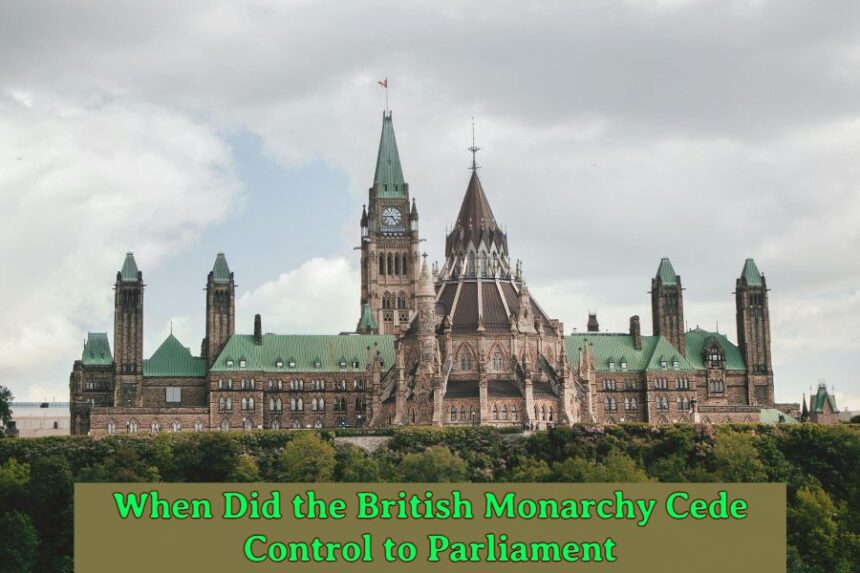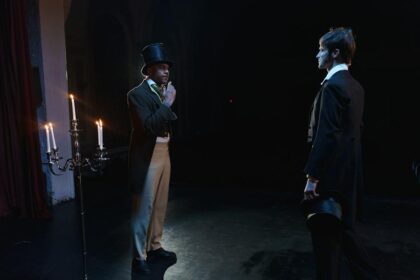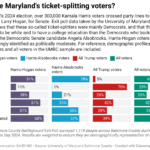The British monarchy began losing power to Parliament following the Glorious Revolution in 1688. This shift was solidified with the signing of the Bill of Rights in 1689.
- The Roots Of British Monarchy
- The Evolution From Absolute To Constitutional Monarchy
- Key Figures In Shaping Early British Political Power
- Magna Carta And The Seed Of Parliament
- The Agreement That Limited The Power Of Kings
- Impacts Of The Magna Carta On The Monarchy-parliament Relationship
- Civil Wars And The Struggle For Sovereignty
- The Glorious Revolution And Bill Of Rights
- William And Mary’s Acceptance Of Parliamentary Conditions
- Institutional Changes And The Monarchy’s Waning Power
- The Hanoverian Succession And Parliamentary Supremacy
- Modern Monarchy And Symbolic Role
- Frequently Asked Questions Of When Did The British Monarchy Lose Power To Parliament
- When Did The Royal Family Lose Political Power?
- When Did British Monarchy Stop Ruling?
- When Did The King Of England Stop Having Absolute Power?
- When Did England Become A Constitutional Monarchy?
- When Did Parliament Overshadow The Monarchy?
- Conclusion
The British political landscape underwent a historic change when King James II fled England, and William III and Mary II ascended the throne, marking the Glorious Revolution’s success. This significant event laid the groundwork for a constitutional monarchy, where the monarch’s rights would no longer be absolute but shared with, and often overruled by, Parliament.
The Bill of Rights that resulted from this power shift limited the monarchy’s prerogatives and affirmed Parliament’s supremacy, including its control over taxes and laws. The gradual evolution towards a more democratic governance continued over the centuries, further reducing the monarchy’s role to symbolic and ceremonial duties, a position formally maintained to this day. Understanding this transition is crucial for those intrigued by the dynamics between monarchical power and parliamentary democracy throughout British history.
The Roots Of British Monarchy
The British Monarchy stands as a pillar in the history of governance. Its rich tapestry began over a millennium ago. During this time, it underwent vast transformation. From wielding definitive power to presiding ceremonially, the monarchy’s journey is fascinating.
The Evolution From Absolute To Constitutional Monarchy
Absolute monarchy dwindled over centuries. England witnessed a dramatic shift. Power gradually transferred to Parliament. This was not a sudden change but a gradual evolution.
Key milestones in this shift include:
- The Magna Carta (1215) – Limited the king’s authority
- The Establishment of Parliament (13th Century) – Consultative gatherings transformed into a legislative body
- The English Civil War (1642-1651) – Pitted royal power against Parliament, leading to a short-lived republic
- The Glorious Revolution (1688) – Established a constitutional monarchy with laws and liberties defined by Parliament
These changes defined a new role for the monarchy. The ruler became more symbolic. Parliamentary rule became the standard.
Key Figures In Shaping Early British Political Power
Several individuals played critical roles in balancing power between the monarchy and Parliament. Their influence was pivotal.
| Figure | Contribution |
|---|---|
| King John | Forced to sign the Magna Carta |
| Oliver Cromwell | Leading figure in the English Civil War against royal absolutism |
| William III and Mary II | Accepted the throne with conditions outlined in the Bill of Rights, 1689 |
These leaders, among others, shaped a parliamentary democracy. They diluted the power once held by a sole ruler. Today’s British System reflects their enduring legacy.
Magna Carta And The Seed Of Parliament
In the meadows of Runnymede, a document set a monumental precedent. The Magna Carta, signed in 1215, sowed the seed for a new era. This era witnessed the rise of a body that would ultimately become the British Parliament. As history unfolded, the British monarchy transitioned from absolute to constitutional. The Magna Carta played a pivotal role in this shift.
The Agreement That Limited The Power Of Kings
King John of England faced rebellious barons armed with a radical demand. They sought to curb the king’s power. Their weapon of choice? The Magna Carta. This document was revolutionary. It subjected the king to the law, stripping away the veneer of divine rule.
Impacts Of The Magna Carta On The Monarchy-parliament Relationship
- Legal Accountability: It introduced the concept that no one, not even the king, was above the law.
- Foundation for Parliament: It paved the way for representative bodies, a key step toward modern Parliament.
- Protection of Rights: It laid down the principle of protecting subjects’ rights, shaping the monarchy-parliament dynamic.
Civil Wars And The Struggle For Sovereignty
The Civil Wars and the Struggle for Sovereignty marks a pivotal chapter in the rich tapestry of British history. This period is renowned for the fierce battle for control between the monarchy and Parliament. The long-standing tussle for power reshaped the nation’s political landscape. It ultimately redefined the role of the British monarchy.
The Rise Of Oliver Cromwell And The Commonwealth
The execution of Charles I in 1649 was a dramatic escalation in the power struggle. It signified Parliament’s triumph over the King. Oliver Cromwell, a military leader and statesman, quickly rose to prominence. He became the Lord Protector of the Commonwealth of England, Scotland, and Ireland. His rule marked the temporarily ousted monarchy and the establishment of a republic.
- Army Reformation: Cromwell reorganized the armed forces, leading to effective governance.
- Parliamentary Rule: He sided with Parliament but clashed with members who challenged his authority.
- Religious Tolerance: Policies implemented under Cromwell allowed greater religious freedom for many, except Catholics.
Restoration Of The Monarchy And Continuing Tensions
Despite the radical change, Cromwell’s Commonwealth was short-lived. The monarchy was restored in 1660 with the accession of Charles II. This signaled the start of the Restoration period.
| Year | Event |
|---|---|
| 1660 | Monarchy Restoration |
| 1688 | Glorious Revolution |
But tensions between Parliament and the crown persisted. Charles II’s rule was marked by an uneasy balance of power. His brother James II faced even greater struggles, leading to his ousting in the Glorious Revolution of 1688. Thus, laid the foundation for a constitutional monarchy. It shifted the sovereignty toward a Parliament-dominated structure.
In sum, this era fortified the principle that no ruler could govern without Parliament’s consent. It was a cornerstone for today’s British constitutional monarchy.
The Glorious Revolution And Bill Of Rights
The Glorious Revolution marks a key moment in British history. It was when Parliament significantly curbed the monarchy’s power. The Bill of Rights in 1689 set the stage for a constitutional monarchy. It made the King’s will subject to the law of the land and Parliament’s will.
William And Mary’s Acceptance Of Parliamentary Conditions
In a peaceful coup, William of Orange and his wife Mary overthrew King James II. But they had conditions to meet. Parliament offered them the throne, but with strings attached. This was unprecedented. They had to agree to govern with Parliament’s consent.
Terms of their rule were clear. William and Mary had to sign the Declaration of Right. This became part of the Bill of Rights. It shaped the crown and Parliament’s future relationship. Key points included:
- No suspending of Parliament’s laws without consent
- No levying of taxes without a grant from Parliament
- Freedom of speech in Parliament
- No penalty for a petition to the king regarding grievances
Institutional Changes And The Monarchy’s Waning Power
The Bill of Rights led to lasting changes. It meant the monarchy no longer had absolute power. They now had to work alongside elected officials.
| Monarch Power Before | After the Bill of Rights |
|---|---|
| Absolute rule | Constitutional monarchy |
| King could dissolve Parliament | Parliamentary sessions regularized |
| No accountability to laws | Subject to rule of law |
The Triennial Act in 1694 took this further. It required Parliament to meet at least once every three years. No longer could a monarch decide if and when to call Parliament. This division of authority was crucial to the changing face of British governance.
Over time, the monarchy’s role as ruler faded to more of a ceremonial stature. Their power diminished, Parliament’s grew. This shift laid the groundwork for modern democracy in Britain. It’s a cornerstone of why the nation prides itself on a longstanding parliamentary system today.
The Hanoverian Succession And Parliamentary Supremacy
The transfer of power from the British monarchy to the English Parliament was a pivotal shift.
This transformation became pronounced during the Hanoverian Succession. The period marked not only a change in the throne but also in the locus of political power.
George I’s Reliance On The Cabinet System
George I, coming to the throne in 1714, spoke little English. His unfamiliarity with the language and customs strengthened the Cabinet’s role.
The cabinet system, under George I, evolved into a de facto executive body.
Ministers gained unprecedented control over government decisions. The King’s reliance on his ministers meant that real power started shifting away from the monarch.
- Secretary of State: Lead in foreign affairs.
- Lord Treasurer: Directed financial policies.
- Others outlined domestic and military policies.
Establishment Of Prime Ministerial Governance
This era birthed the role of the Prime Minister. With Robert Walpole, often considered the first Prime Minister, the precedent was set.
Walpole’s tenure established the groundwork for Prime Ministerial governance. The Prime Minister’s role grew as the central coordinator of Cabinet policy. It enforced parliamentary supremacy.
| Impact on Monarchy | Impact on Parliament |
|---|---|
| Monarch’s political power diminished. | Parliament’s decision-making authority elevated. |
| Royal assent became a formality. | Legislation and government oversight strengthened. |
The Prime Minister and Cabinet derived their power from Parliament, not the crown.
This evolution entrenched Parliament as the ultimate authority in British politics.
Modern Monarchy And Symbolic Role
The British monarchy has transitioned from ruling to reigning without direct political power. Today’s royals don’t make laws. They hold ceremonial titles.
Queen Victoria’s symbolic monarchy
Queen Victoria’s Symbolic Monarchy
Queen Victoria marked a shift in royal influence. Her reign began in 1837. It lasted until 1901. She became a symbol of the era.
- Victoria’s reign is famed for an empire’s expansion.
- Political power moved to Parliament during her time.
- The Queen became the ‘grandmother of Europe’.
- Her role was mostly ceremonial. It shaped the symbolic nature of modern monarchy.
The current British monarchy’s role and influence
The Current British Monarchy’s Role And Influence
The current British monarchy continues a symbolic tradition. They influence through presence, not governance. They represent unity and continuity.
Their activities include:
| Role | Influence |
|---|---|
| Charity support | Raising awareness, funds |
| State ceremonies | Upholding traditions |
| Diplomacy | State visits, hosting leaders |
| National events | Celebrations, remembrances |
Royals like Queen Elizabeth II and Prince Charles serve as figureheads. They connect the nation to its history. They focus on social issues.
Frequently Asked Questions Of When Did The British Monarchy Lose Power To Parliament
When Did The Royal Family Lose Political Power?
The British royal family’s political power diminished significantly in 1688 during the Glorious Revolution. Subsequent constitutional developments through the 19th century further reduced their political role.
When Did British Monarchy Stop Ruling?
The British monarchy ceased to rule directly in 1688 following the Glorious Revolution, which limited the monarch’s power and led to a constitutional monarchy.
When Did The King Of England Stop Having Absolute Power?
The King of England’s absolute power effectively ended with the Glorious Revolution in 1688.
When Did England Become A Constitutional Monarchy?
England transitioned to a constitutional monarchy in 1688 following the Glorious Revolution.
When Did Parliament Overshadow The Monarchy?
The transition of power from the British monarchy to Parliament was a gradual process, with significant shifts occurring during the 17th century, particularly after the Glorious Revolution in 1688.
Conclusion
The British monarchy’s power evolved over centuries, shifting towards parliamentary democracy. Key events, like the Glorious Revolution and the signing of the Bill of Rights in 1689, sparked this transition. Understanding this shift enhances our grasp on modern governance. The monarchy’s ceremonial role now underscores a rich political heritage, with Parliament at the helm of legislative authority.




